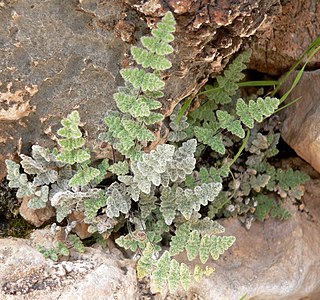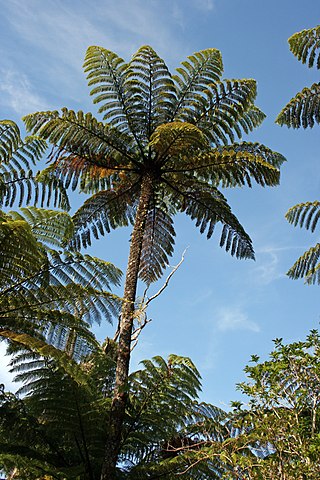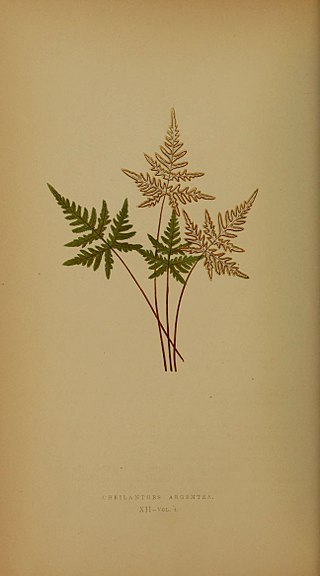
Pteris (brake) is a genus of about 300 species of ferns in the subfamily Pteridoideae of the family Pteridaceae. They are native to tropical and subtropical regions, southward to New Zealand, Australia, and South Africa, north to Japan and North America. 78 species are found in China. Some species of Pteris have considerable economic and ecological value, such as Pteris multifida, Pteris ensiformis, Pteris vittata can be used for ornamental purposes; as a hyperaccumulator, Pteris multifida and Pteris vittata can be used to control soil pollution.

Cheilanthes, commonly known as lip ferns, is a genus of about 180 species of rock-dwelling ferns with a cosmopolitan distribution in warm, dry, rocky regions, often growing in small crevices high up on cliffs. Most are small, sturdy and evergreen. The leaves, often densely covered in trichomes, spring directly from the rootstocks. Many of them are desert ferns, curling up during dry times and reviving with the coming of moisture. At the ends of veins sporangia, or spore-bearing structures, are protected by leaf margins, which curl over them.

Cyathea is a genus of tree ferns, the type genus of the fern order Cyatheales.

Pellaea is a genus of ferns in the Cheilanthoideae subfamily of the Pteridaceae. The genus name is derived from the Greek word πελλος (pellos), meaning "dark," and refers to the brown stems. Many members of the genus are commonly known as cliffbrakes. They primarily grow in rocky habitats, including moist rocky canyons, slopes, and bluffs.

Notholaena, cloak fern, is a genus of ferns in the Cheilanthoideae subfamily of the Pteridaceae. Ferns of this genus are mostly epipetric or occurring in coarse, gravelly soils, and are most abundant and diverse in the mountain ranges of warm arid or semiarid regions. They typically have a creeping or erect rhizome and leaves that are pinnatifid to pinnate-pinnatifid with marginal sori protected by a false indusium formed from the reflexed margin of the leaf. Members of Notholaena also have a coating of whitish or yellowish farina on the surfaces of the leaves. The farina is often limited to the abaxial (lower) leaf surface, but may occur on the adaxial (upper) leaf surface as well. Members of the related Pentagramma genus have a similar lower leaf-surface farina.

Pleopeltis is a genus of ferns in the family Polypodiaceae, subfamily Polypodioideae, according to the Pteridophyte Phylogeny Group classification of 2016 (PPG I). The genus widely distributed in tropical regions of the world, and also north into temperate regions in eastern North America and eastern Asia. Several species are known by the common name scaly polypody and resurrection fern.

Aleuritopteris is a genus of ferns in the Cheilanthoideae subfamily of the Pteridaceae. As with some other genera of the Cheilanthoideae, molecular phylogenetic studies have suggested that it is not monophyletic, and so may need to be circumscribed differently in future.

Campyloneurum is a genus of ferns in the family Polypodiaceae, subfamily Polypodioideae, according to the Pteridophyte Phylogeny Group classification of 2016 (PPG I). They are commonly known as strap ferns.

Tectaria is a genus of fern in the family Tectariaceae, according to the Pteridophyte Phylogeny Group classification of 2016. Halberd fern is a common name for species in this genus.
Enterosora is a genus of ferns in the family Polypodiaceae, subfamily Grammitidoideae, according to the Pteridophyte Phylogeny Group classification of 2016 (PPG I). PPG I also recognizes the genus Zygophlebia, which more recent sources include in Enterosora. As of February 2019, many do not have formally published names in Enterosora and are retained here in Zygophlebia.

Argyrochosma is a genus of ferns known commonly as false cloak ferns. The genus is included in the Cheilanthoideae subfamily of the Pteridaceae. Species now in this genus were previously treated as members of related genera Notholaena or Pellaea but were segregated into their own genus in 1987. These ferns, of which there are about 20 species, are mostly native to the Americas, from North to South and including the Caribbean, while one species, A. connectens, is known from Sichuan, China. They are commonly found growing in cracks between rocks. Their leaves are generally shorter than 40 cm (16 in) and have rounded bluish or grayish green segments. Often the lower surface of the segments is coated in a white dust, and the sporangia contain brown spores.

Lomariopsis is the type genus of the fern family Lomariopsidaceae.

Hypolepis (beadfern) is a genus of ferns described as a genus in 1806. The word is derived from Greek, meaning "under scale". It is found in tropical and subtropical regions, primarily in the New World but also in the Old World and on various oceanic islands.

Doryopteris is a genus of ferns in the subfamily Cheilanthoideae of the family Pteridaceae.

Polypodium is a genus of ferns in the family Polypodiaceae, subfamily Polypodioideae, according to the Pteridophyte Phylogeny Group classification of 2016 (PPG I). The genus is widely distributed throughout the world, with the highest species diversity in the tropics. The name is derived from Ancient Greek poly ("many") + podion, on account of the foot-like appearance of the rhizome and its branches. They are commonly called polypodies or rockcap ferns, but for many species unique vernacular names exist.

Amauropelta is a genus of ferns in the family Thelypteridaceae, subfamily Thelypteridoideae, in the Pteridophyte Phylogeny Group classification of 2016. Other sources sink the genus into a very broadly defined genus Thelypteris.
Stigmatopteris is a genus of ferns in the family Dryopteridaceae, subfamily Polybotryoideae, in the Pteridophyte Phylogeny Group classification of 2016.

Triplophyllum is a genus of ferns in the family Tectariaceae, according to the Pteridophyte Phylogeny Group classification of 2016 (PPG I).

Serpocaulon is a genus of ferns in the family Polypodiaceae, subfamily Polypodioideae, according to the Pteridophyte Phylogeny Group classification of 2016 (PPG I). The genus is native to Northern and Southern America.

















